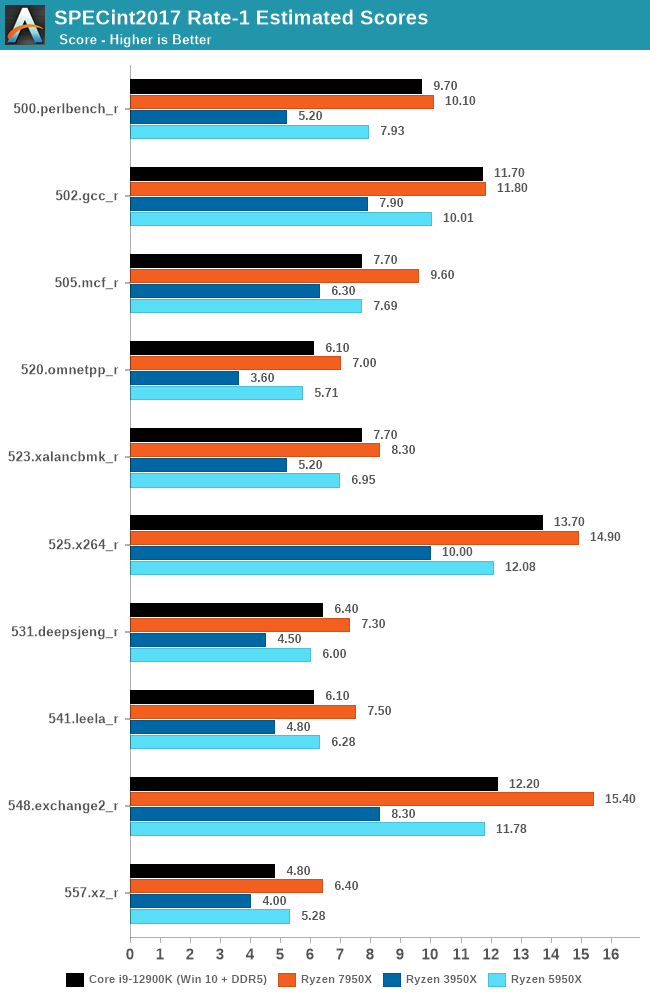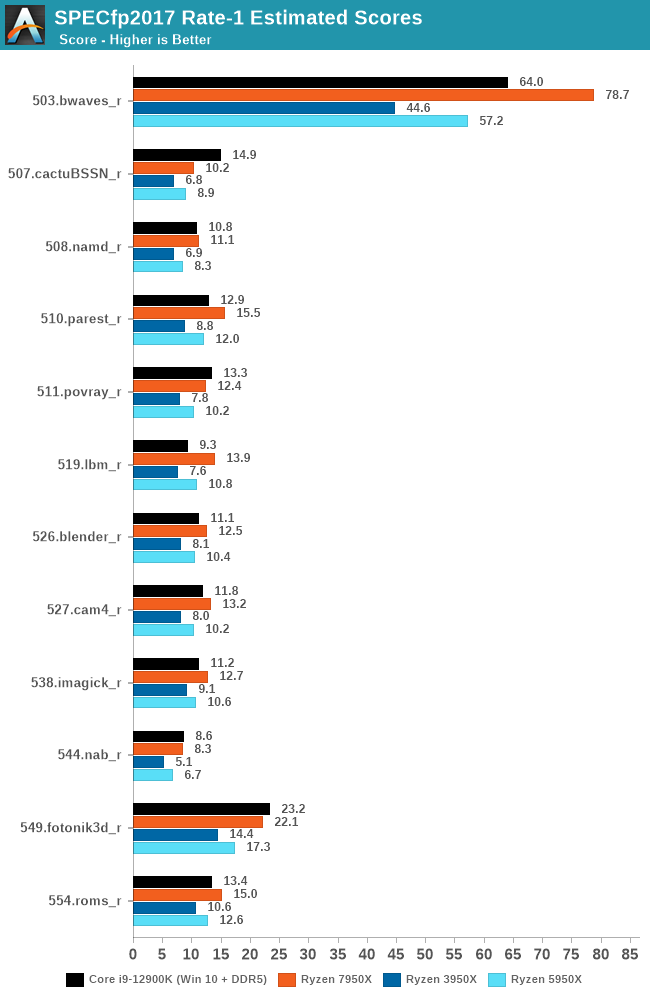AMD Zen 4 Ryzen 9 7950X and Ryzen 5 7600X Review: Retaking The High-End
by Ryan Smith & Gavin Bonshor on September 26, 2022 9:00 AM ESTSPEC2017 Single-Threaded Results
SPEC2017 is a series of standardized tests used to probe the overall performance between different systems, different architectures, different microarchitectures, and setups. The code has to be compiled, and then the results can be submitted to an online database for comparison. It covers a range of integer and floating point workloads, and can be very optimized for each CPU, so it is important to check how the benchmarks are being compiled and run.
We run the tests in a harness built through Windows Subsystem for Linux, developed by Andrei Frumusanu. WSL has some odd quirks, with one test not running due to a WSL fixed stack size, but for like-for-like testing it is good enough. Because our scores aren’t official submissions, as per SPEC guidelines we have to declare them as internal estimates on our part.
For compilers, we use LLVM both for C/C++ and Fortan tests, and for Fortran we’re using the Flang compiler. The rationale of using LLVM over GCC is better cross-platform comparisons to platforms that have only have LLVM support and future articles where we’ll investigate this aspect more. We’re not considering closed-sourced compilers such as MSVC or ICC.
clang version 10.0.0
clang version 7.0.1 (ssh://git@github.com/flang-compiler/flang-driver.git
24bd54da5c41af04838bbe7b68f830840d47fc03)
-Ofast -fomit-frame-pointer
-march=x86-64
-mtune=core-avx2
-mfma -mavx -mavx2
Our compiler flags are straightforward, with basic –Ofast and relevant ISA switches to allow for AVX2 instructions.
To note, the requirements for the SPEC licence state that any benchmark results from SPEC have to be labelled ‘estimated’ until they are verified on the SPEC website as a meaningful representation of the expected performance. This is most often done by the big companies and OEMs to showcase performance to customers, however is quite over the top for what we do as reviewers.

Starting off with single-threaded performance in SPECint2017, we can see that AMD's new Zen 4 core performs when compared directly with its previous Zen 3 and even more so, its Zen 2 microarchitecture. In 500.perlbench_r, the Ryzen 9 7950X has a 27% uplift over the previous Zen 3 based Ryzen 9 5950X, with a massive 94% uplift in single-threaded performance over the Zen 2 based Ryzen 9 3950X. This in itself is impressive, with similar levels of performance increase in other SPECint2017 tests such as a 23% increase over the previous generation in 525.x264_r and 30% in the 548.exchange2_r test.
The performance increase can be explained by a number of variables, including the switch from DDR4 to DDR5 memory, as well as a large increase in clock speed.

Moving onto our SPECfp2017 1T results, we see a similar increase in performance as in the previous set of 1T-tests. Focusing on the 503.bwaves_r, we are seeing an uplift of 37% over Zen 3. Interestingly, the performance in 549.fotonik3d, we see an increase of around 27% over the Ryzen 9 3950X, although Intel's Alder Lake architecture which is also on DDR5 is outperforming the Ryzen 9 7950X.
Perhaps the biggest increase in Zen 4's improvement in IPC over Zen 3 is through doubling the L2 cache on the 7950X (16MB) versus the 5950X (8MB). Similarly, both the Ryzen 9 7950X and 5950X have a large pool of L3 cache (64MB), but the 7950X boosts up to 5.7 GHz on a single core providing the core temperature is below 50°C, or 5.6 GHz if above 50°C.
As it stands at the time of writing, AMD's Ryzen 9 7950X is the clear leader in single-core IPC performance, with a pretty comprehensive increase in IPC performance over Zen 3. Although Intel's Alder Lake (12th Gen) provided gains over AMD's Ryzen 5000 series in a multitude of ways including frequency, optimizations, and its complex hybrid architecture. There is no doubt that the latest Zen 4 microarchitecture using TSMC's 5 nm node gives AMD the single-thread performance crown, and in terms of single-threaded applications, it's the most powerful x86 desktop processor right now.










205 Comments
View All Comments
Freeb!rd - Monday, September 26, 2022 - link
This paragraph reads like someone having a stroke while writing it..."Although this is overridable through manually overclocking with a maximum TJ Max of up to 115°C, it’s key tovitalte that users will need to use more premium and aggressive cooling types to squeeze every last drop of performance from ZAMD intended thistended when designing Zen 4, and as such, has opted not to bundls own CPU coolers with the retail packages."
and someone's spell checker is broken.
gryer7421 - Monday, September 26, 2022 - link
It reads like a GTP-3 BOT .... :(Threska - Monday, September 26, 2022 - link
We now know "Zencally " is a word.Gavin Bonshor - Monday, September 26, 2022 - link
Hi, yeah something screwy happened, but it's fixed now. Apologies. I think it may be time to update to a new system, and software. This isn't the first time it's jumbled stuff up for me.Cow86 - Monday, September 26, 2022 - link
I wish I could say that all the errors in the article are fixed, but that very paragraph even still has several (big) errors in it... A missing letter is one thing, half a sentence just missing and going into the next is another.herozeros - Monday, September 26, 2022 - link
Keep the copy editor awake, or fire them. Grammar/syntax/CMS error, it doesn't matter if it gives me a headache reading this.Ryan Smith - Monday, September 26, 2022 - link
Unfortunately we're having to do this kind of live. It's been a very busy past two weeks and we haven't had as much time to prepare as we like. So most of what you're seeing is first-draft copy, which I'll get around to editing as I can.Digital publications do not employ dedicated copy editors any more. They have all been let go for cost efficiency reasons.
flyingpants265 - Monday, September 26, 2022 - link
What? Come on now.Hifihedgehog - Monday, September 26, 2022 - link
@flypants265: It's kind of like Microsoft who got rid of their QA team and made all of their developers honorary QA tests. They can't help it that their leadership is being stupid. Don't blame Ryan or Gavin. Blame these greedy cheapskates that likewise didn't want to pay Ian Cutress enough to want to stay.Hifihedgehog - Monday, September 26, 2022 - link
*QA testers